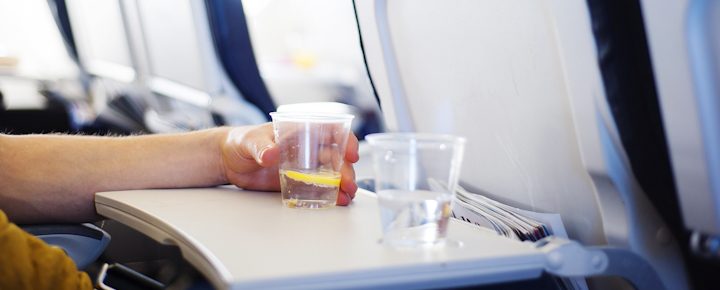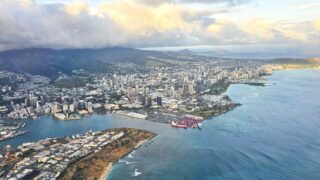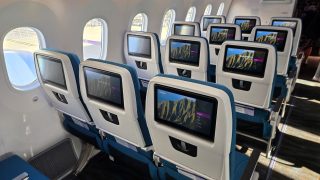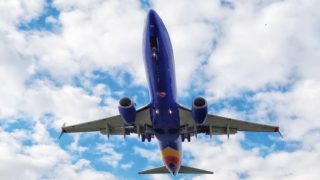The quality of drinking water on U.S. airlines and the violations of standards associated with each company vary widely. Read on for all the details related to Hawaii, then get ready to consider implementing changes to your airline behavior, including bringing your own water.
The safest airline water of those companies flying to Hawaii is found on Alaska Airlines, followed by Hawaiian Airlines. The previous study came from Hunter College NYC Food Policy Center and DietDetective.com, and we had a look back at it to see what they uncovered. There is no more recent data, unfortunately.
Federal standards for airline drinking water.
It is called Aircraft Drinking Water Rule or ADWR. That was begun a decade ago to assure passengers and crew of safe drinking water. We weren’t previously aware of these regulations ourselves. As a side note, the EPA has not sought penalties in most cases of standards violations.
“The primary purpose of the Aircraft Drinking Water Rule (ADWR) is to ensure that safe and reliable drinking water is provided to aircraft passengers and crew.”
Originally water safety laws were designed to apply to stationary public water systems. The EPA modified those rules to create ones more appropriate to airlines.
Three federal government agencies are responsible for airline drinking water safety.
The EPA is the primary agency and regulates water systems at airports and onboard aircraft. The FDA regulates water used in food and drink preparation and in the water supply lines of aircraft. Lastly, the FAA oversees airline operations and maintenance, including the drinking water systems.
When the EPA first looked into this in 2004, they found that airline potable water systems were out of compliance with national standards designed for stationary rather than mobile systems.
The differences between stationary and airline drinking water systems are vast.
Airplanes have tight operating schedules and fly to multiple places on any day. Drinking water may be brought on at any destination. Airlines board water using temporary connections that can become compromised.
Airline drinking water quality can vary depending on the water itself that was boarded, issues associated with loading the water, and the systems on the plane for potable water and their maintenance.
Prior to the first rules associated with airlines, EPA required 45 airlines to agree to corrective measures related to water safety.
In the study, 23 airlines were ranked in drinking water quality on their flights. Scores ranged from zero for the lowest quality to five for the highest quality. Scoring was based on ten things, including prior violations, positive tests for E. coli and coliform bacteria, fleet size, and airline cooperation on these issues. Generally, the study says that a score of 3 or greater is a good thing, although we didn’t feel completely comfortable even then. You’ll see why.
Airlines must sample, flush and disinfect their water tanks to prevent bacterial contamination. There are two options, with it done either quarterly or annually, but with monthly testing.
The study gives their “shame on you” award to the EPA for their handling of these matters and for “nearly all major airlines” in regards to poor response and lack of cooperation in addressing these issues. American and United were called out for not addressing questions related to many violations in the last seven years.
Recommendations for airline passengers.
1. Travelers should consume 8 ounces of water per hour.
2. Never drink water on board that isn’t dispensed from a sealed bottle. Both Alaska and Hawaiian serve water during beverage service directly from sealed containers.
3. Bring your own coffee or tea; those from the airline should not be consumed as the water used is obtained from their potable water system.
4. Should you wash your hands in the airplane lavatory? This is controversial, but there are indications that using hand sanitizer may be a healthier habit to practice instead.
What about the safety of ice on airlines?
Ice on aircraft was not addressed in the airline drinking water study. It has been suggested that this is another potential source of bacterial contamination in beverages that should be investigated. What we’ve heard is this. It is always safest to order your airline drink without ice.
This study isn’t about bottled water.
Remember that this study isn’t about the airline opening a bottle of water and serving it to you directly from the bottle. This is about anything that uses the onboard potable/drinking water system.
Airline rankings and standards violations.
Alaska Airlines: 3.3. Total violations between 2012 and 2019: 2
Hawaiian Airlines: 3.1. Total violations between 2012 and 2019: 25
Southwest Airlines: 2.4. Total violations between 2012 and 2019: 33
Delta Air Lines: 1.6. Total violations between 2012 and 2019: 213
American Airlines: 1.5. Total violations between 2012 and 2019: 108
United Airlines: 1.2. Total violations between 2012 and 2019: 79
Note: you cannot directly compare the number of violations between airlines since they have vastly different fleet sizes. This data is through 2019, and there is no newer data available.
What are your personal airline drinking water, beverage, and ice practices on flights to Hawaii and elsewhere?
Get Breaking Hawaii Travel News







We typically fly United and Jet Blue, they serve bottled water and have Never seen water served any other way. Coffee and Tea is a different story and most likely does come from the potable on board system, So Far I haven’t had any problems associated with drinking coffee but now I will probably avoid it in the future. Thank You BOH for the information, very interesting.
Hi Ernie.
Thank you too! Happy travels.
Aloha.
I normally use American from DFW and on these flights like all international services, water is served in sealed bottles.
“Travelers should consume 8 ounces of water per hour.” I fly fairly often and find that amount of consumption to be overkill. From west coast cities that is over 40 ounces per per person. We fly pretty regularly from LAX or LGB to the islands. A 24 ounce bottle is quite sufficient. I have never felt I was not getting enough hydration on four and a half ounces per hour. Added to that is any drink service on the plane.
I would like to see the total violations with the total number of flights flown to get a better perspective. American always serves you water from a large bottle except for the times during Covid when they handed you a bag with a mini bottle of water, cookie, and a sanitized wet wipe.
If you’re near a Starbucks have them give you a large (Venti) cup of water. They have the best water filtration with reverse osmosis equipment. It’s free too.
I flew United last week and for the first time I’ve ever seen, they had sealed individual water bottles for everyone in all cabins. I always travel with a Life Straw Bottle or the equivalent and filter my water where ever I go.
Looks like Alaska may have the safest water. Too bad they don’t have a real first class.
8 ounces of water an hour while on the plane -I rarely drink more than 16 ounces of water a day. That goes with 2-3 cups of coffee and about 2 liters of Diet Coke.
I know, I know – my wife hounds me about it all the time. But, at 78 years of age (on Aug 22) I’m unlikely to change.
When I fly, I usually have Diet Coke and coffee. Because I’m diabetic I avoid one of my favorite beverages – orange juice. My daughter-in-law has a half gallon in the fridge and I stare at it and just reach for the Diet Coke.
Hi Rod.
Thanks for 300 comments! And congrats in advance on your upcoming birthday.
Aloha.
I was on an Alaska flight earlier this year and they were handing out pint size cartons of what I thought was milk. Why would they be doing that? Well, it was water. Trying to be a bit more “Green” with recycling. Caught me by surprise.
We generally bring bottled water with us on flights, but do use airline ice. We drink coffee or tea because we assume the water has been boiled at some point, and any bacteria would be killed. Perhaps that’s not a good assumption–after reading your article. I was surprised at the advice to drink 8 oz per hour, but it makes sense since flying is very dehydrating. I just hate to make the trek down the aisle to the lavatory any more often than absolutely necessary.
Interesting article–thanks for the information.
Hi Lee
Thanks! Happy travels.
Aloha.
Southwest also serves water from a sealed container, Deja Blue is the brand name.
So travelers drinking 8 ounces of water per hour will need to use the lavatory at least a few times during their long flights from the US mainland. Just imagine what will happen when the airplane encounters extended turbulence and passengers cannot leave their seats for hours at a time, or not at all on this long flight.
I bring my own bottled water onboard and drink only from cans if I drink anything from airplane. I have a sensitive stomach so I always have my own water. Shame on the EPA for not following up on this. No one wants a stomach bug on vacation!
Sadly Oahu use to be guaranteed fresh until someone leaked some fuel……I’d rather take my chances on airline H20 ….. gotta have a desalination plant or something?
The fuel leak didn’t contaminate Honolulu water, it was confined to the Base. Honolulu contamination is due to “other” problems and has existed years prior to the fuel. What’s happening to the water on Oahu has many causes, some attributed to shoddy work performed on the sewer systems.
Wow! Great article regarding something S important! Thanks for always keeping us up to date on so many things! You do an amazing job and I never delete your emails without reading them! Always subjects of great interest. I appreciate all your hard work, investigative reports, all airline updates, geez- so many things! Thank you!
Hi Toni.
You just made both of our days! Thank you very much. Comments like yours inspire us to keep writing.
Aloha.
Aloha! I have been bringing my own empty, reusable water bottle through security for years. Began the practice when my children were old enough to do the same. We made a game of who could find the first (filtered) water bottle filling station near a water fountain. Those stations are much easier to find these days, but in the past, would resort to asking a bartender to “fill ‘em up” (with water!) as well. No coffee or tea for me on flights!
Never considered how or when the airlines cleans their water tanks, Thank you for this insight.
This is a shame. I will bring my own coffee and drink from bottled water only 👀